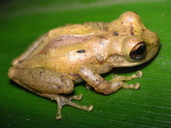|
Flectonotus fitzgeraldi (Parker, 1934)
Dwarf Marsupial Frog | family: Hemiphractidae genus: Flectonotus |
 © 2008 Dr Joanna M Smith (1 of 2) |
|
|
|
Description Coloration: The dorsum is yellowish brown, while the posterior surfaces are pale brown. The venter is unpigmented, but speckled with white on the chest. Coloration of the iris is varied from a dull pale bronze to golden, and a reddish brown streak exists on either side of the pupil (Duellman and Gray 1983). Variation: Dorsal patterns are present in three-fourths of individuals. However there is no pattern post-sacrum. The faint dorsal markings of two preserved specimens from Trinidad showed more definite brown markings after preservation (Duellman and Gray 1983). Tadpole Morphology: Tadpoles are less than 20 mm in length with muscular tails. Their small mouths lack denticles and are oriented anteroventrally. Their snouts are dull, with reduced, weakly cornified beaks (Duellman and Gray 1983). Diagnosis: The closest known relative of F. fitzgeraldi is F. pygmaeus. F. fitzgeraldi is distinguishable from F. pygmaeus by its smaller size. Foot length in both males and females is a significant means for separating these species. In F. fitzgeraldi, foot length is 5.9-7.9 mm and 7.2-9.6 mm in males and females respectively. In F. pygmaeus foot length is 8.4-11.1 mm in males and 10.6-12.5 mm in females. In addition to foot length, internarial distance, tibia length, eye-to-nostril distance, interorbital distance, nostril-jaw distance, head length, and eye diameter may be useful in distinguishing species among male individuals. Internarial distance, tibia length, eye-to-nostril distance, nostril-jaw distance, head width, and thumb length may be useful in distinguishing species among female individuals (Duellman and Gray 1983). Distribution and Habitat Country distribution from AmphibiaWeb's database: Trinidad and Tobago, Venezuela
Life History, Abundance, Activity, and Special Behaviors Throughout the year on Trinidad, F. fitzgeraldi call for about an hour after sunset. Their calls are brief, biphasic notes that sound like crickets chirping (Duellman and Gray 1983). Mating behavior is unknown, but members of Flectonotus are known to have long reproductive seasons and if females were to mate within a week or two after egg deposit, they could theoretically have five broods per season. A female will produce 3-4 embryos, 3.3 on average, with a mean diameter of 3.6 mm. Eggs will brood in her dorsal pouch until developmental stages 39-41. They are then released into bromeliads and aroid leaf bases, where they continue to develop without feeding. Larval development takes place in only 5 days and during this time, only yolk is consumed (Duellman and Gray 1983). Trends and Threats Some populations are conserved within Parque Nacional Peninsula de Paria in Venezuela and some inhabit protected rainforests in Tobago (Stuart et al. 2008). Possible reasons for amphibian decline General habitat alteration and loss Comments The primitive number of chromosomes in hylid frogs is 26, however F. fitzgeraldi has 28 (Duellman and Gray 1983).
References
Duellman, W. E., and Gray, P. (1983). "Developmental biology and systematics of the egg-brooding hylid frogs, genera Flectonotus and Fritziana." Herpetologica, 39(4), 333-359. Frost, D. (2011). Amphibian Species of the World: an Online Reference. Version 5.5. Stuart, S., Hoffmann, M., Chanson, J., Cox, N., Berridge, R., Ramani, P., Young, B. (eds) (2008). Threatened Amphibians of the World. Lynx Edicions, IUCN, and Conservation International, Barcelona, Spain; Gland, Switzerland; and Arlington, Virginia, USA. Originally submitted by: Jacob Villard (first posted 2011-06-23) Edited by: Mingna (Vicky) Zhuang (2012-04-05) Species Account Citation: AmphibiaWeb 2012 Flectonotus fitzgeraldi: Dwarf Marsupial Frog <https://amphibiaweb.org/species/1358> University of California, Berkeley, CA, USA. Accessed Apr 30, 2025.
Feedback or comments about this page.
Citation: AmphibiaWeb. 2025. <https://amphibiaweb.org> University of California, Berkeley, CA, USA. Accessed 30 Apr 2025. AmphibiaWeb's policy on data use. |


 Map of Life
Map of Life